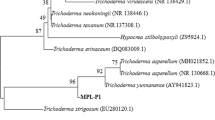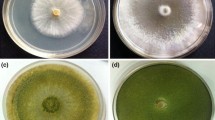Abstract
Trichoderma spp. are widely applied, eco-friendly mycofungicides and plant growth promoters. Native Trichoderma strains are likely to have more productive, stable biocontrol and biofertilizer activities since they are well adapted to the local environment. In this study, we isolated a native Trichoderma strain ‘Th62’ from the rhizosphere soil of wild Chelidonium majus plants in Harbin, China (126.6341°E, 45.7242°N). The isolated Trichoderma strain was identified as a T. harzianum strain via morphological observation and molecular methods based on the rDNA internal transcribed spacer region and elongation factor-1α gene sequences. Significant antagonistic activities of Th62 against five soil-borne fungal phytopathogens, Fusarium oxysporum, Sclerotinia sclerotiorum, Alternaria alternata, Cytospora chrysosperma, and Rhizoctonia solani, were confirmed by dual-culture assays. Furthermore, the crude fermentation products of Th62 also displayed antifungal activities against these five pathogens. To evaluate the function of Th62 as a biofertilizer, we subsequently applied Th62 on cockscomb (Celosia cristata L), a plant species with both ornamental and medicinal values, by inoculation with Th62 conidia at different concentrations, 1 × 1010 cfu mL−1, 1 × 1011 cfu mL−1, and 1 × 1012 cfu mL−1. The beneficial effects of Th62 were evaluated by measuring the growth and photosynthetic traits of the inoculated cockscomb plants, and the results demonstrated that Th62 significantly improved the photosynthetic efficiency, photosynthetic capacity, and the adaptability to intense light of the inoculated cockscomb plants compared to the controls. Consistently, Th62 inoculation significantly improved the growth and flower yield of cockscomb. We presented a positive case of isolating and applying native microbial resources on local plantation practices.




Similar content being viewed by others
Change history
25 November 2021
A Correction to this paper has been published: https://doi.org/10.1007/s13580-021-00409-z
References
Adnan M, Islam W, Shabbir A, Khan KA, Ghramh HA, Huang Z, Chen HYH, Lu G (2019) Plant defense against fungal pathogens by antagonistic fungi with Trichoderma in focus. Microb Pathogen 129:7–18. https://doi.org/10.1016/j.micpath.2019.01.042
Atanasova L, Crom SL, Gruber S, Coulpier F, Seidl-Seiboth V, Kubicek CP, Druzhinina IS (2013) Comparative transcriptomics reveals different strategies of Trichoderma mycoparasitism. BMC Genomics 14:121–135. https://doi.org/10.1186/1471-2164-14-121
Bae H, Roberts DP, Lim HS, Strem MD, Park SC, Ryu CM, Melnick RL, Bailey BA (2011) Endophytic Trichoderma isolates from tropical environments delay disease onset and induce resistance against Phytophthora capsici in hot pepper using multiple mechanisms. Mol Plant Microbe Inter J 24:336–351. https://doi.org/10.1094/MPMI-09-10-0221
Chaverri P, Castlebury LA, Samuels GJ, Geiser DM (2003) Multilocus phylogenetic structure within the Trichoderma harzianum/Hypocrea lixii complex. Mol Phylogenet Evol 27:302–313. https://doi.org/10.1094/MPMI-09-10-022110.1016/S1055-7903(02)00400-1
Cornelissen JHC, Lavorel S, Garnier E, Díaz S, Buchmann N, Gurvich DE, Reich PB, ter Steege H, Morgan HD, van der Heijden MGA, Pausas JG, Poorter H (2003) A hand book of protocols for standardized and easy measurement of plant functional traits worldwide. Aust J Bot 51:335–380. CSIRO. https://doi.org/10.1071/BT021240067-1924/03/040335
Cui S, Zhang T, Zhao S, Li P, Zhou Q, Zhang Q, Han Q (2013) Evaluation of three ornamental plants for phytoremediation of PB-contamined soil. Int J Phytoremed 15:299–306. https://doi.org/10.1080/15226514.2012.694502
Elad Y, Chet I, Henis Y (1981) Biological control of Rhizoctonia solani in strawberry fields by Trichoderma harzianum. Plant Soil 60:245–254. https://doi.org/10.1007/BF02374109
Farquhar GD, Caemmerer S, Berry JA (1980) A biochemical model of photosynthetic CO2 assimilation in leaves of C3 species. Planta 149:78–90. https://doi.org/10.1007/BF00386231
Farquhar GD, von Caemmerer S, Berry JA (2001) Models of photosynthesis. Plant Physiol 125:42–45. https://doi.org/10.1104/pp.125.1.42
Gruber S, Seidl-Seiboth V (2012) Self versus non-self: fungal cell wall degradation in Trichoderma. Microbiology 158:26–34. https://doi.org/10.1099/mic.0.052613-0
Harman GE, Howell CR, Viterbo A, Chet I, Lorito M (2004) Trichoderma species-opportunistic, avirulent plant symbionts. Nat Rev Microbiol 2:43–56. https://doi.org/10.1038/nrmicro797
Harman GE, Doni F, Khadka RB, Uphoff N (2019) Endophytic strains of Trichoderma increase plants’ photosynthetic capability. J Appl Microbiol jam.14368. https://doi.org/10.1111/jam.14368
Hebert PDN, Cywinska A, Ball SL, de Waard JR (2003) Biological identifications through DNA barcodes. Proc Biol Sci 270:313–321. https://doi.org/10.1098/rspb.2002.2218
Hermosa MR, Grondona I, Iturriaga ET, Diaz-Minguez JM, Castro C, Monte E, Garcia-Acha I (2000) Molecular characterization and identification of biocontrol isolates of Trichoderma spp. Appl Environ Microbiol 66:1890–1898. https://doi.org/10.1128/AEM.66.5.1890-1898.2000
Jiang Y, Wang JL, Chen J, Mao LJ, Feng XX, Zhang CL, Lin FC (2016) Trichoderma biodiversity of agricultural fields in East China reveals a gradient distribution of species. PLoS One 11:e0160613. https://doi.org/10.1371/journal.pone.0160613
Joshi D, Misra SC (2013) Characterization of Trichoderma isolates from sugarcane agro-ecosystem and their efficacy against colletotrichum falcatum causing red rot of sugarcane. Sugar Technol 15:192–196. https://doi.org/10.1007/s12355-013-0208-y
Kim YS, Hwang JW, Sung SH, Jeon YJ, Jeong JH, Jeon BT, Moon SH, Park PJ (2015) Antioxidant activity and protective effect of extract of Celosia cristata L. flower on tert-butyl hydroperoxide-induced oxidative hepatotoxicity. Food Chem 168:572–579. https://doi.org/10.1016/j.foodchem.2014.07.106
Kopchinskiy A, Komoń M, Kubicek CP, Druzhinina IS (2005) TrichoBLAST: a multilocus database for Trichoderma and Hypocrea identifications. Mycol Res 109:658–660. https://doi.org/10.1017/S0953756205233397
Kullnig-Gradinger CM, Szakacs G, Kubicek CP (2002) Phylogeny and evolution of the genus Trichoderma: a multigene approach. Mycol Res 106:757–767. https://doi.org/10.1017/S0953756202006172
Lapsansky ER, Milroy AM, Andales MJ, Vivanco JM (2016) Soil memory as a potential mechanism for encouraging sustainable plant health and productivity. Curr Opin Biotechnol 38:137–142. https://doi.org/10.1016/j.copbio.2016.01.014
Li CW, Song RQ, Yang LB, Deng X (2015) Isolation, purification, and structural identification of an antifungal compound from a Trichoderma strain. J Microbiol Biotechnol 25:1257–1264. https://doi.org/10.4014/jmb.1410.10027
Liu LN, Zhang JZ, Xu T (2009) Histopathological studies of sclerotia of Rhizoctonia solani parasitized by the EGFP transform ant of Trichoderma virens. Lett Appl Microbiol 49:745–750. https://doi.org/10.1111/j.1472-765X.2009.02737.x
Mariela ON, Renato AS, Gil RS, Cléia AO, Danival JS (2017) Antagonism of Trichoderma isolates against Leucoagaricus gongylophorus (singer) Möller. J Basic Microbiol 57:699–704. https://doi.org/10.1002/jobm.201600755
Matheny PB (2005) Improving phylogenetic inference of mushrooms with RPB1 and RPB2 nucleotide sequences (Inocybe; Agaricales). Mol Phylogenet Evol 35:1–20. https://doi.org/10.1016/j.ympev.2004.11.014
Mayo S, Gutiérrez S, Gutierrez S, Malmierca MG, Lorenzanal A, Campelol MP, Hermosa R, Casquero PA (2015) Influence of Rhizoctonia solani and Trichoderma spp. in growth of bean (Phaseolus vulgaris L.) and in the induction of plant defense-related genes. Front Plant Sci 6:685. https://doi.org/10.3389/fpls.2015.00685
Mendoza-Mendoza A, Zaid R, Lawry R, Hermosa R, Monte E, Horwitz BA, Mukherjee PK (2018) Molecular dialogues between Trichoderma and roots: role of the fungal secretome. Fungal Biol Rev 32:62–85. https://doi.org/10.1016/j.fbr.2017.12.001
Mukherjee PK, Horwitz BA, Kenerley CM (2012) Secondary metabolism in Trichoderma - a genomic perspective. Microbiology 158:35–45. https://doi.org/10.1099/mic.0.053629-0
Qin WT, Zhuang WY (2016) Seven wood-inhabiting new species of the genus Trichoderma (Fungi, Ascomycota) in Viride clade. Sci Rep 6:1–15. https://doi.org/10.1038/srep30100
Samuels GJ (2006) Trichoderma: systematics, the sexual state, and ecology. Phytopathology 96:195–206. https://doi.org/10.1094/PHYTO-96-0195
Santhoshkumar M, Baskaran L, Mahakavi T, Bakiyaraj R (2018) Assessment of phytoremediation potential of cockscomb (Celosia cristata L.) in chlorpyrifos polluted soil. Int J Curr Res Biosci Plant Biol 5:60–71. https://doi.org/10.20546/ijcrbp.2018.504.009
Singh S, Kumar Rahul Yadav S, Kumar Raushan Singh RK (2018) Effect of bio-control agents on soil borne pathogens: a review. J Pharmacogn Phytochem 7:406–411
Sun ZL, Gao GL, Xia YF, Feng J, Qiao ZY (2011) A new hepoprotective saponin from Semen Celosia cristatae. Fitoterapia 82:591–594. https://doi.org/10.1016/j.fitote.2011.01.007
Topolovec-Pintarić S (2019) Trichoderma: invisible partner for visible impact on agriculture. In: Trichoderma-The Most Widely Used Fungicide. IntechOpen. https://doi.org/10.5772/intechopen.83363
Tu WF, Li Y, Liu W, Wu LS, Xie XY, Zhang YM, Wilhelm C, Yang CH (2016) Spring ephemerals adapt to extremely high light conditions via an unusual stabilization of photosystem II. Front Plant Sci 6:1189. https://doi.org/10.3389/fpls.2015.01189
Vinale F, Ghisalberti EL, Sivasithamparam K, Marra R, Ritieni A, Ferracane R, Woo S, Lorito M (2009) Factors affecting the production of Trichoderma harzianum secondary metabolites during the interaction with different plant pathogens. Lett Appl Microbiol 48:705–711. https://doi.org/10.1111/j.1472-765X.2009.02599.x
Vitti A, Monaca EL, Sofo A, Scopa A, Cuypers A, Nuzzaci M (2015) Beneficial effects of Trichoderma harzianum T-22 in tomato seedlings infected by cucumber mosaic virus (CMV). BioControl 60:135–147. https://doi.org/10.1007/s10526-014-9626-3
Wang Y, Lou Z, Wu QB, Guo ML (2010) A novel hepatoprotective saponin from Celosia cristata L. Fitoterapia 81:1246–1252. https://doi.org/10.1016/j.fitote.2010.08.011
Yuan SF, Tang HP, Yan YC (2009) Photosynthetic characteristics of spring ephemerals in the desert ecosystem of Dzungaria Basin, Northwest China. Environ Earth Sci 59:501–510. https://doi.org/10.1007/s12665-009-0047-z
Zhai T, Wang Y, Liu C, Liu Z, Zhao M, Chang Y, Zhang R (2019) Trichoderma asperellum ACCC30536 inoculation improves soil nutrition and leaf artemisinin production in Artemisia annua. Acta Physiol Plant 41:46. https://doi.org/10.1007/s11738-019-2836-7
Zhang F, Huo Y, Cobb AB, Luo G, Zhou J, Yang G, Wilson GWT, Zhang Y (2018) Trichoderma biofertilizer links to altered soil chemistry, altered microbial communities, and improved grassland biomass. Front Microbiol 9:848. https://doi.org/10.3389/fmicb.2018.00848
Acknowledgements
This study was funded by the National Natural Science Foundation of China (NSFC: 31370642), and the postdoctoral science-research developmental foundation of Heilongjiang Province (LBH-Q11176), and the Joint Guidance (Lian-He-Yin-Dao) project of the Natural Science Foundation of Heilongjiang Province (grant No. LH2019C015).
Author information
Authors and Affiliations
Contributions
RZ designed this study. YW and XH wrote the manuscript. CJ and TZ conducted the experiments. RM, JD, ZY, YW, and XH performed statistical analyses and the making of the figures.
Corresponding author
Ethics declarations
Conflict of interest
The authors declare that they have no conflict of interest.
Additional information
Communicated by So-Young Park, Ph.D.
Publisher's Note
Springer Nature remains neutral with regard to jurisdictional claims in published maps and institutional affiliations.
The original online version of this article was revised: The order that the authors appeared in the author list and the affiliations of Yue‑Feng Wang were incorrect.
Rights and permissions
About this article
Cite this article
Hou, XY., Wang, YF., Jiang, CY. et al. A native Trichoderma harzianum strain Th62 displays antagonistic activities against phytopathogenic fungi and promotes the growth of Celosia cristata. Hortic. Environ. Biotechnol. 62, 169–179 (2021). https://doi.org/10.1007/s13580-020-00307-w
Received:
Revised:
Accepted:
Published:
Issue Date:
DOI: https://doi.org/10.1007/s13580-020-00307-w




